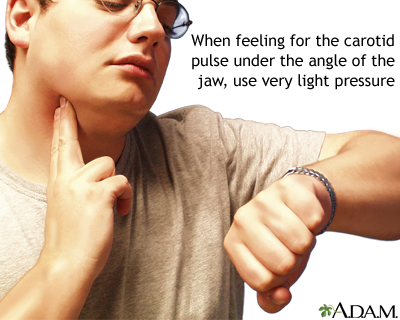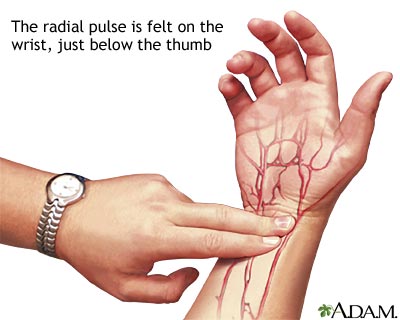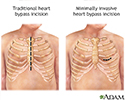Heart bypass surgery - minimally invasive - discharge
Minimally invasive direct coronary artery bypass - discharge; MIDCAB - discharge; Robot assisted coronary artery bypass - discharge; RACAB - discharge; Keyhole heart surgery - discharge; Coronary artery disease - MIDCAB discharge; CAD - MIDCAB discharge
Heart bypass surgery creates a new route, called a bypass, for blood and oxygen to reach your heart.
Minimally invasive coronary (heart) artery bypass can be done without stopping the heart. Therefore, you DO NOT need to be put on a heart-lung machine for this procedure.
This article discusses what you need to do to care for yourself after you leave the hospital.
When You're in the Hospital
You had minimally invasive coronary artery bypass surgery on one or more of your coronary arteries. Your surgeon used an artery from your chest to create a detour, or bypass, around arteries that were blocked and could not bring blood to your heart. A 3- to 5-inch-long (7.5 to 12.5 centimeters) cut (incision) was made in the left part of your chest between your ribs. This allowed your doctor to reach your heart.
What to Expect at Home
You may be able to leave the hospital 2 or 3 days after surgery. You may also be able to return to normal activities after 2 or 3 weeks.
After surgery, it is normal to:
- Feel tired.
- Have some shortness of breath. This may be worse if you also have lung problems. Some patients may use oxygen when they go home.
- Have pain in the chest area around the wound.
Self-care
You may want to have someone stay with you in your home for the first week.
Learn how to check your pulse, and check it every day.
Do the breathing exercises you learned in the hospital for the first 1 to 2 weeks.
Weigh yourself every day.
Shower every day, washing your incision gently with soap and water. DO NOT swim, soak in a hot tub, or take baths until your incision is completely healed. Follow a heart-healthy diet.
If you are feeling depressed, talk with your family and friends. Ask your health care provider about getting help from a counselor.
Continue to take all your medicines for your heart, diabetes, high blood pressure, or any other conditions you have.
- DO NOT stop taking any medicine without talking with your provider.
-
Your provider may recommend antiplatelet drugs (blood thinners) -- such as
aspirin
,
clopidogrel
(Plavix), prasugrel (Effient), or ticagrelor (Brilinta) -- to help keep your artery graft open.
Aspirin
Blood thinners - aspirin; Antiplatelet therapy - aspirin
 ImageRead Article Now Book Mark Article
ImageRead Article Now Book Mark ArticleClopidogrel
Blood thinners - clopidogrel; Antiplatelet therapy - clopidogrel; Thienopyridines
 ImageRead Article Now Book Mark Article
ImageRead Article Now Book Mark Article - If you are taking a blood thinner such as warfarin (Coumadin), you may have extra blood tests to make sure your dose is correct.
Know how to respond to angina symptoms .
Know how to respond to angina symptoms
Acute coronary syndrome - chest pain; Coronary artery disease - chest pain; CAD - chest pain; Coronary heart disease - chest pain; ACS - chest pain; ...
Activity
Stay active during your recovery, but start slowly. Ask your provider how active you should be.
- Walking is a good exercise after surgery. DO NOT worry about how fast you walk. Take it slow.
- Climbing stairs is OK, but be careful. Balance may be a problem. Rest halfway up the stairs if you need to.
- Light household chores, such as setting the table and folding clothes should be OK.
- Slowly increase the amount and intensity of your activities over the first 3 months.
- DO NOT exercise outside when it is too cold or too hot.
- Stop if you feel short of breath, dizzy, or any pain in your chest. Avoid any activity or exercise that causes pulling or pain across your chest, such as using a rowing machine or weight lifting.
- Keep your incision area protected from the sun to avoid sunburn.
Be careful how you use your arms and upper body when you move around for the first 2 or 3 weeks after your surgery. Ask your provider when you may return to work. For the first week after surgery:
- DO NOT reach backward.
- DO NOT let anyone pull on your arms for any reason -- for instance, if they are helping you move around or get out of bed.
- DO NOT lift anything heavier than about 10 pounds (4.5 kilograms). (This is a little more than a gallon, or 4 liters, of milk.)
- Avoid other activities in which you need to keep your arms above your shoulders for any period of time.
- DO NOT drive. The twisting involved in turning the steering wheel may pull on your incision.
You may be referred to a cardiac rehabilitation program. You will get information and counseling about activity, diet, and exercise.
When to Call the Doctor
Call your provider if:
- You have chest pain or shortness of breath that does not go away when you rest.
- Your pulse feels irregular -- it is very slow (fewer than 60 beats a minute) or very fast (over 100 to 120 beats a minute).
- You have dizziness, fainting, or you are very tired.
- You have a severe headache that does not go away.
- You have a cough that does not go away.
- You are coughing up blood or yellow or green mucus.
- You have problems taking any of your heart medicines.
- Your weight goes up by more than 2 pounds (1 kilogram) in a day for 2 days in a row.
- Your wound is red or swelling, it has opened, or there is more drainage coming from it.
- You have chills or a fever over 101°F (38.3°C).
References
Fihn SD, Gardin JM, Abrams J, et al. 2012 ACCF/AHA/ACP/AATS/PCNA/SCAI/STS guideline for the diagnosis and management of patients with stable ischemic heart disease: executive summary: a report of the American College of Cardiology Foundation/American Heart Association Task Force on practice guidelines, and the American College of Physicians, American Association for Thoracic Surgery, Preventive Cardiovascular Nurses Association, Society for Cardiovascular Angiography and Interventions, and Society of Thoracic Surgeons. Circulation . 2012;126(25):3097-3137. PMID: 23166210 www.ncbi.nlm.nih.gov/pubmed/23166210 .
Hillis LD, Smith PK, Anderson JL, et al. 2011 ACCF/AHA Guideline for Coronary Artery Bypass Graft Surgery. A report of the American College of Cardiology Foundation/American Heart Association Task Force on Practice Guidelines. Developed in collaboration with the American Association for Thoracic Surgery, Society of Cardiovascular Anesthesiologists, and Society of Thoracic Surgeons. J Am Coll Cardiol . 2011;58(24):e123-e210. PMID: 22070836 www.ncbi.nlm.nih.gov/pubmed/22070836 .
Omer S, Cornwell LD, Bakaeen FG. Acquired heart disease. In: Townsend CM Jr., Beauchamp RD, Evers BM, Mattox KL, eds. Sabiston Textbook of Surgery . 20th ed. Philadelphia, PA: Elsevier; 2017:chap 59.
Vandvik PO, Lincoff AM, Gore JM, et al. Primary and secondary prevention of cardiovascular disease: antithrombotic therapy and prevention of thrombosis, 9th ed: American College of Chest Physicians evidence-based clinical practice guidelines. Chest . 2012;141(2 Suppl):e637S-e668S. PMID: 22315274 www.ncbi.nlm.nih.gov/pubmed/22315274 .
-
Heart bypass surgery incision - illustration
Minimally invasive heart bypass surgery is done without stopping the heart and putting the patient on a heart-lung machine. A 3 to 5 inch (8 to 13 cm) incision is made in the left part of the chest between the ribs. This incision is much less traumatic than the traditional heart bypass surgery incision which separates the breast bone. Minimally invasive heart bypass surgery allows the patient less pain and a faster recovery.
Heart bypass surgery incision
illustration
-
Taking your carotid pulse - illustration
The carotid arteries take oxygenated blood from the heart to the brain. The pulse from the carotids may be felt on either side of the front of the neck just below the angle of the jaw. This rhythmic "beat" is caused by varying volumes of blood being pushed out of the heart toward the extremities.
Taking your carotid pulse
illustration
-
Radial pulse - illustration
Arteries carry oxygenated blood away from the heart to the tissues of the body. Veins carry blood depleted of oxygen from the same tissues back to the heart. The arteries are the vessels with the "pulse," a rhythmic pushing of the blood in the heart followed by a refilling of the heart chamber. To determine heart rate, one counts the beats at a pulse point like the inside of the wrist for 10 seconds, and multiplies this number by 6. This is the per-minute total.
Radial pulse
illustration
-
Heart bypass surgery incision - illustration
Minimally invasive heart bypass surgery is done without stopping the heart and putting the patient on a heart-lung machine. A 3 to 5 inch (8 to 13 cm) incision is made in the left part of the chest between the ribs. This incision is much less traumatic than the traditional heart bypass surgery incision which separates the breast bone. Minimally invasive heart bypass surgery allows the patient less pain and a faster recovery.
Heart bypass surgery incision
illustration
-
Taking your carotid pulse - illustration
The carotid arteries take oxygenated blood from the heart to the brain. The pulse from the carotids may be felt on either side of the front of the neck just below the angle of the jaw. This rhythmic "beat" is caused by varying volumes of blood being pushed out of the heart toward the extremities.
Taking your carotid pulse
illustration
-
Radial pulse - illustration
Arteries carry oxygenated blood away from the heart to the tissues of the body. Veins carry blood depleted of oxygen from the same tissues back to the heart. The arteries are the vessels with the "pulse," a rhythmic pushing of the blood in the heart followed by a refilling of the heart chamber. To determine heart rate, one counts the beats at a pulse point like the inside of the wrist for 10 seconds, and multiplies this number by 6. This is the per-minute total.
Radial pulse
illustration
-
Gallstones and gallbladder disease
(In-Depth)
Review Date: 8/2/2016
Reviewed By: Michael A. Chen, MD, PhD, Associate Professor of Medicine, Division of Cardiology, Harborview Medical Center, University of Washington Medical School, Seattle, WA. Also reviewed by David Zieve, MD, MHA, Isla Ogilvie, PhD, and the A.D.A.M. Editorial team.





